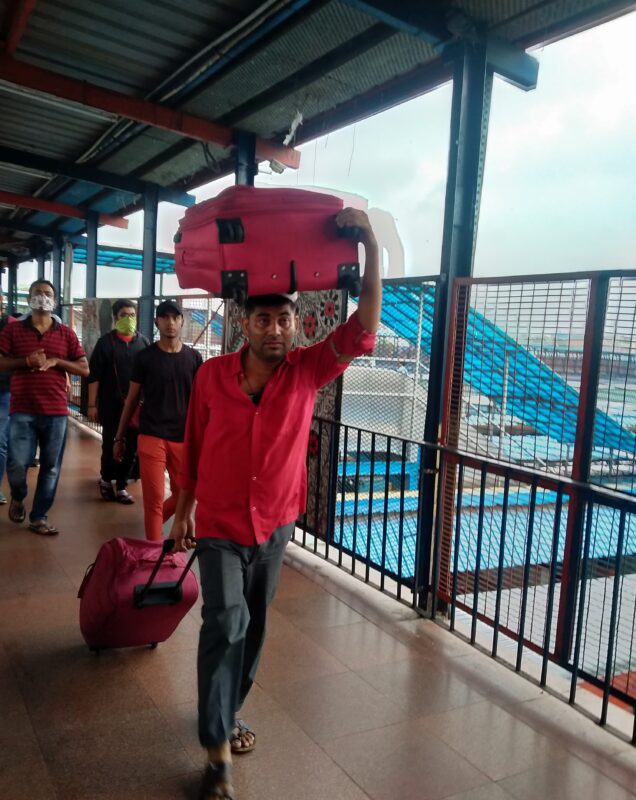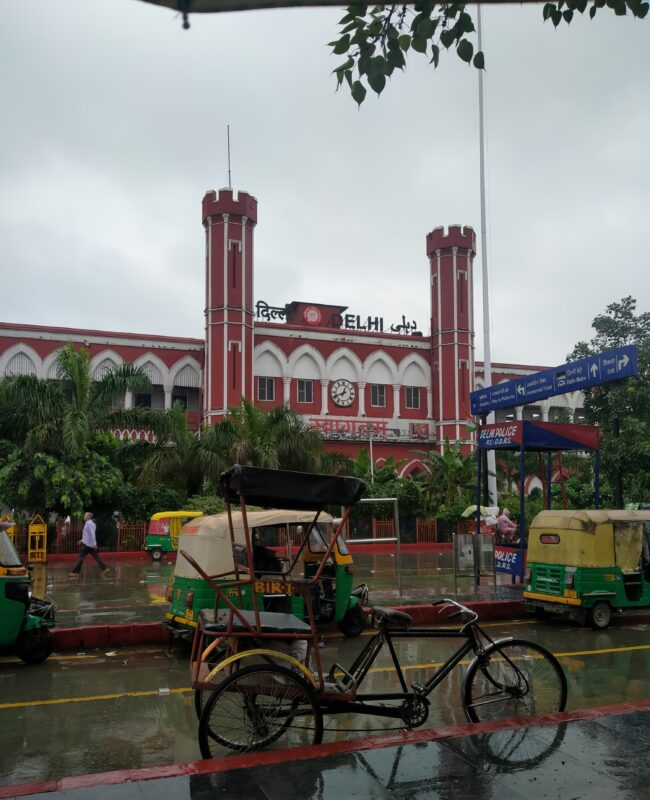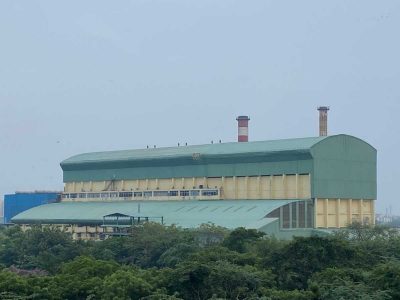Like so many of his co-workers, Phool Singh, in his mid-thirties, wears a bright red shirt and copper armband. After finishing his tea and rusk at a stall in front of New Delhi railway station, his eyes desperately scan the crowd searching for a grahak (customer).
It is 11:30 in the morning and Singh hasn’t been able to get a single customer. “There are days like this when there is no work. It is difficult to manage my expenses but I don’t have any other option,” asserts Singh, who has been a porter here for 11 years.
Singh continues, “It was in 2011 when I came to Delhi from Rajasthan. My father was also a coolie. The babus ( officers) asked me to lift a 50-kg load. My back hurt and I also felt bad but my father told me that this is my destiny and the sooner I accept it, the better. We don’t have work back in town and I am not even educated enough.”
Porters not only carry over oversized luggage on their heads but are asked by random passengers about the exact location of the coaches of train. They are like search engines in being able to impart exact, updated information about the platform number and arrival time of the train. Though this information is available on various apps, many people are unaware of how to tap the data.
Survival mode
Beyond the train journey, do we ever spare a thought about the plight of porters? Do we wonder about how they became the bearers of our load? What are their working conditions?
“Cooligiri provides bread and butter to my family back in the village,” says one such porter, Kapil. “I live in Nizamuddin Basti and start my day with Taj Express that leaves the station at 5:50 am. I can’t afford to keep my family here with me, the rent is too much. I share the room with three more people who sell vegetables.”
His oldest son pleads with him to leave the job as it is not regarded as respectable. “How do I tell him that I am not educated like him? My joints hurt and at the night I take pain killers or rub ‘Move’ ointment to feel relaxed. There’s no future in cooligiri now,” he concludes.

rent of the rooms in Delhi.
Other options
Coolies were once the go-to option for passengers at railway stations. People would haggle over the fee, using the cheap labour at a time when there was no alternative.
With modernisation, there has been a sea change. Courtesy the new infrastructure and better facilities available for travellers, the services of a coolie are often not needed.
“This footover bridge that you are looking at has affected the work. Now, people don’t want to call a coolie because they can easily manage via the bridge. It connects the metro exit gates to the platforms,” tells Sushil Kumar Meena, a porter.
Notably, the beautiful bridge addresses the needs of the travellers quite uniquely. The modular bridge is artistically decorated, making the walk tempting, especially for those whose suitcases have wheels. Coolies, of course, wish the bridge were never built.
At stations across India, including New Delhi Railway Station, there are lifts and escalators that make the small trek to the platform easy. Golf carts and e-rickshaws are available to take passengers, especially the aged and the very young, from the departure terminal to the exact place on the platform where their coach will arrive.
New Delhi Railways Station is a major transportation node with approximate average foot fall of 450,000 people daily. From here you can get onto the Delhi metro network, with a subterranean underground station that connects two lines:, the Airport Express Line and the Yellow Line at the railway station.

No alternatives
Meena also hails from Rajasthan and has been working at New Delhi railway station since 2002. As this migrant worker from Jodhpur stands under a neem tree outside the station entrance, his eyes become moist while speaking of his family.
He says, “During Covid I went back to the family because everything was at a standstill. For the first time in my life I was afraid I would not be able to feed my kids. The government didn’t notice us. Now, people think that the country is bouncing back but for coolies, this is not the case.”
What exactly is his income from hauling loads? He earns Rs 300 a day and if he gets lucky, upto Rs 500, not more than that. “Once we had good work here but now improvements such as escalators and wheeled suitcases has majorly hit us. People take their luggage on their own and just ignore our call,” he rues.
In the year 2016, the coolies were renamed as sahayaks by Minister of Railways Suresh Prabhu. The move was taken so that the negative connotations of the term can fade away. However, the efforts didn’t seem to have changed working condition for the coolies.
Similarly, Balveer Chauhan, a porter from Bharatpur, believes that so much has changed especially in the past decade that they have to sometimes go to sleep with a hungry belly because they have minimal work. He says in his husky voice, “Naam badal dene se haalat nahi badal jaate” (changing the name doesn’t bring a change in conditions).
Rude passengers
Rajpal, porter number 842, at Purani Dilli railway station, is enjoying the drizzle on Sunday afternoon. Why not? The rain has brought relief from the heat and his son has got his bachelor’s degree in Rajasthan.
“I want my son to do a good job,” he says. “There’s nothing left in cooligiri. Moreover, the passengers treat us badly. They don’t seem to trust us. They think we will not carry the luggage properly or demand too much money. But they probably don’t understand what we go through. Nobody listen to our woes.”
He has a specific grouse in mind. “Yesterday, a passenger wanted me to carry four big bulky suitcases from Platform No. 1 to Platform No. 12 minutes before the train’s departure. The man, who seemed to in his lates twenties, kept yelling at me. I felt humiliated and asked myself in retrospect what I had done to deserve such treatment.”
When the Patriot asked Rajpal whether there’s a union who represents the porters, he says, “We have a sangathan (union) but there’s a lack of awareness. We need more rights. The way we are treated is disgusting. Can you believe we are asked to line up at entrances of the station? We stand even in rain and 45 degrees in summer like queues of taxis and three-wheelers. Where is humanity?”
Demand vs supply
There are around 1,400 porters scrounging for work across the four junctions in Delhi. However, the need has reduced to 400 now. There’s no fixed rate for carrying the load. It all depends on individual bargaining.
RC Patel, the Pradhan (president of union) explained, “There are basically two ways by which the coolies are recruited, one is through vacancies that the Indian railways put out and another is badge transfer system. The former is hardly followed. The recruitment of coolies in India basically runs on the system of badge transfer. As per the policy of railways, coolies who no longer feel fit to work can surrender their badges by transferring it to their relatives (son, brother, nephew or brother-in-law).
“Not all commuters are bad,” interrupted Hari Singh, a porter at Nizamuddin Railway Station. “These eyes have seen a lot in the past 25 years. There are kind people too. For instance, when the passengers are in hurry and because of us they are able to catch their train, they reward us out of sheer happiness. Some people also help us cope with kind words. Commuters who are really kind sometimes simply ask us about our family while waiting for the train at the station. That’s the life of a coolie function here,” sums up Singh.
Was it just chance that Patriot was finding porters from Rajasthan? No, it is not a coincidence, they say. “Roughly 80% of the coolies belong to Rajasthan. This is because there’s no fertile land there. Hence, we migrate to Delhi in search of work. Our father and even grandfathers did the same.”
A simple badge transfer, and the coolie can start working. The transfer started with 1,400 porters alone at New Delhi Railway Station but with time many of them moved to Nizamuddin or Purani Dilli. We need to be more organized. Our union still lacks the knowledge and awareness of the basic rights that we deserve. We don’t even have a proper coolie shelter at the station. Times have changed but for not for us.”
Instagram: instagram.com/thepatriot_in/
Twitter: twitter.com/Patriot_Delhi
Facebook: facebook.com/Thepatriotnewsindia





